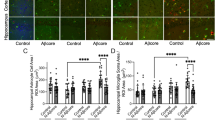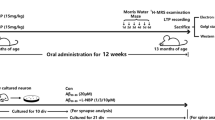In primary culture of mouse hippocampal neurons, peptide EDR (200 ng/ml) under conditions of amyloid synaptotoxicity (a model of Alzheimer’s disease) increased the number of mushroom spines by 71% and returned this parameter to the normal level. Under the same conditions, tripeptide KED (200 ng/ml) increased the number of mushroom spines in hippocampal neurons by 20%. Tripeptide EDR can be recommended for further experimental study as a candidate neuroprotective agent for prevention and treatment of Alzheimer’s disease.
Similar content being viewed by others
Change history
03 October 2017
A correction to this article has been published.
References
Bashkireva AS, Artamonova VG. The peptide correction of neurotic disorders among professional truck-drivers. Adv. Gerontol. 2012;25(4):718-728.
Umnov RS, Lin’kova NS, Khavinson VKh. Neuroprotective effects of peptides bioregulators in people of various age. Adv. Gerontol. 2013;26(4):671-678.
Khavinson VKh, Kuznik BI, Ryzhak GA. Peptide bioregulators: the new class of geroprotectors. Message 2. Clinical studies results. Adv. Gerontol. 2013;26(1):20-37.
Khavinson VKh, Lin’kova NS, Evlashkina EV, Durnova AO, Kozlov KL, Gutop OE. Molecular aspects of anti-atherosclerotic effects of short peptides. Bull. Exp. Biol. Med. 2014;158(1):159-163.
Arutjunyan A, Kozina L, Stvolinskiy S, Bulygina Y, Mashkina A, Khavinson V. Pinealon protects the rat offspring from prenatal hyperhomocysteinemia. Int J. Clin. Exp. Med. 2012;5(2):179-185.
Borlikova GG, Trejo M, Mably AJ, Mc Donald JM, Sala Frigerio C, Regan CM, Murphy KJ, Masliah E, Walsh DM. Alzheimer brain-derived amyloid b-protein impairs synaptic remodeling and memory consolidation. Neurobiol. Aging. 2013;34(5):1315-1327.
Bourne J, Harris KM. Do thin spines learn to be mushroom spines that remember? Curr. Opin. Neurobiol. 2007;17(3):381-386.
Bourne JN, Harris KM. Balancing structure and function at hippocampal dendritic spines. Annu. Rev. Neurosci. 2008;31:47-67.
Brookmeyer R, Johnson E, Ziegler-Graham K, Arrighi HM. Forecasting the global burden of Alzheimer’s disease. Alzheimers Dement. 2007;3(3):186-191.
Penzes P, Cahill ME, Jones KA, VanLeeuwen JE, Woolfrey KM. Dendritic spine pathology in neuropsychiatric disorders. Nat. Neurosci. 2011;14(3):285-293.
Popugaeva E, Pchitskaya E, Speshilova A, Alexandrov S, Zhang H, Vlasova O, Bezprozvanny I. STIM2 protects hippocampal mushroom spines from amyloid synaptotoxicity. Mol. Neurodegener. 2015;10):37. doi: 10.1186/s13024-015-0034-7.
Rodriguez A, Ehlenberger DB, Dickstein DL, Hof PR, Wearne SL. Automated three-dimensional detection and shape classification of dendritic spines from fluorescence microscopy images. PLoS One. 2008;3(4):e1997. doi: https://doi.org/10.1371/journal.pone.0001997.
Sun S, Zhang H, Liu J, Popugaeva E, Xu NJ, Feske S, White CL 3rd, Bezprozvanny I. Reduced synaptic STIM2 expression and impaired store-operated calcium entry cause destabilization of mature spines in mutant presenilin mice. Neuron. 2014;82(1):79-93.
Wei ZH, He QB, Wang H, Su BH, Chen HZ. Meta-analysis: the efficacy of nootropic agent Cerebrolysin in the treatment of Alzheimer’s disease. J. Neural Transm. (Vienna). 2007; 114(5):629-634.
Author information
Authors and Affiliations
Corresponding author
Additional information
Translated from Kletochnye Tekhnologii v Biologii i Meditsine, No. 2, pp. 101-104, June, 2017
A correction to this article is available online at https://doi.org/10.1007/s10517-017-3882-z.
Rights and permissions
About this article
Cite this article
Kraskovskaya, N.A., Kukanova, E.O., Lin’kova, N.S. et al. Tripeptides Restore the Number of Neuronal Spines under Conditions of In Vitro Modeled Alzheimer’s Disease. Bull Exp Biol Med 163, 550–553 (2017). https://doi.org/10.1007/s10517-017-3847-2
Received:
Published:
Issue Date:
DOI: https://doi.org/10.1007/s10517-017-3847-2




